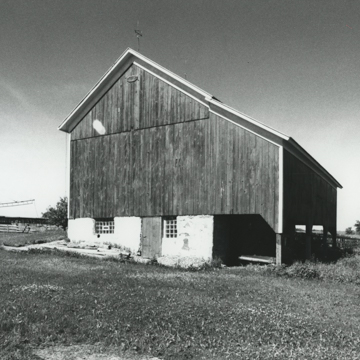Forebay barns—often called Pennsylvania, Pomeranian, or Wisconsin porch barns—are a special type of bank or basement barn associated with German immigrants. In Wisconsin, examples cluster in Marathon, Lincoln, Ozaukee, and Green counties. The characteristic forebay or overshot, a second-floor extension, jutted out over the barnyard to protect the cattle doors below from snow drifts and to provide an open-air shelter for the cows. Historical geographers have argued that German immigrants living in Pennsylvania developed the forebay design, which then spread westward. These examples in Marathon County, however, were built by German immigrants who moved directly to Wisconsin, so it seems likely that the barns were based on European prototypes, which were commonplace. These forebay barns are often referred to as “Wisconsin porch barns.” Each is gable-roofed with a raised fieldstone basement and a haymow constructed of vertical wooden siding. Their deep forebays are framed independently from the rest of the structure and are supported by posts, unlike the cantilevered structures found in Pennsylvania and in Green County. Almost all have at least one gabled wall-dormer on the forebay side.
The Town of Berlin is particularly rich in forebay barns. The John and Mathilda Pagel Barn (1905; 11299 Lincoln Drive) typifies the Wisconsin porch barn with its braced posts, two large gabled dormers, and small rectangular windows at regular intervals. The August and Henrietta Seefeld Barn (c. 1900; 12382 Lincoln) is similar. The two August and Minna Schuster Barns (1890; 14209 Naugart Drive) are forebay barns. The larger one is a true bank barn, built into the gentle slope of the hill. Its dropped forebay and its wall dormer are offset slightly from center.















